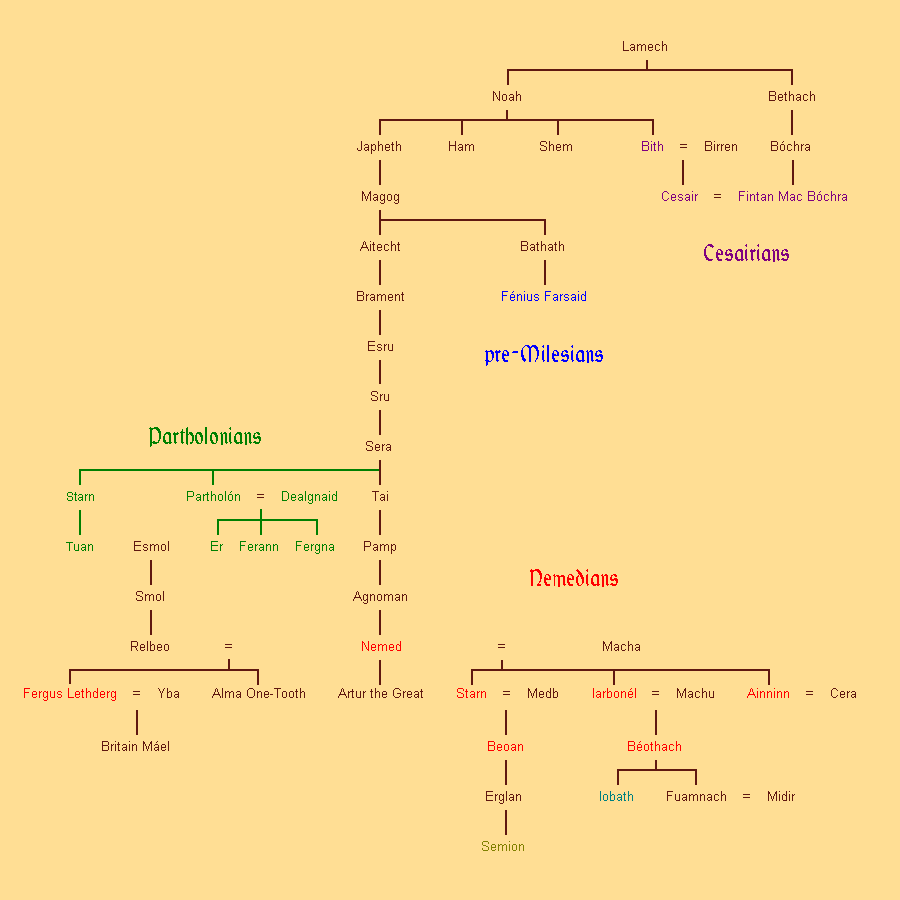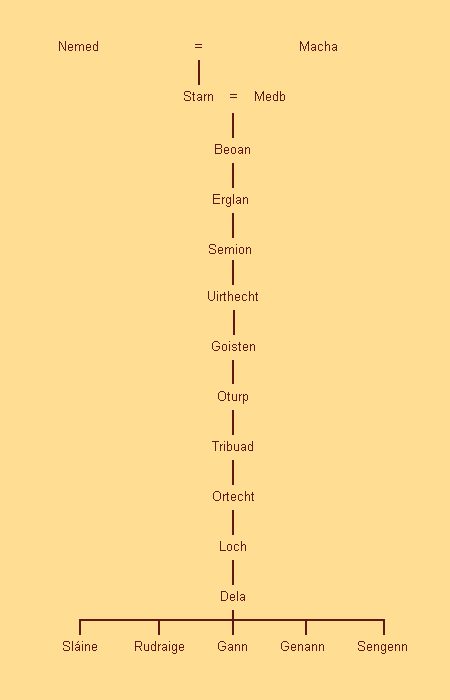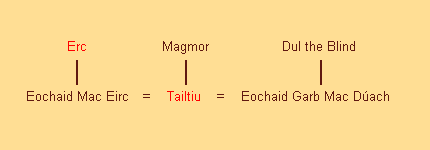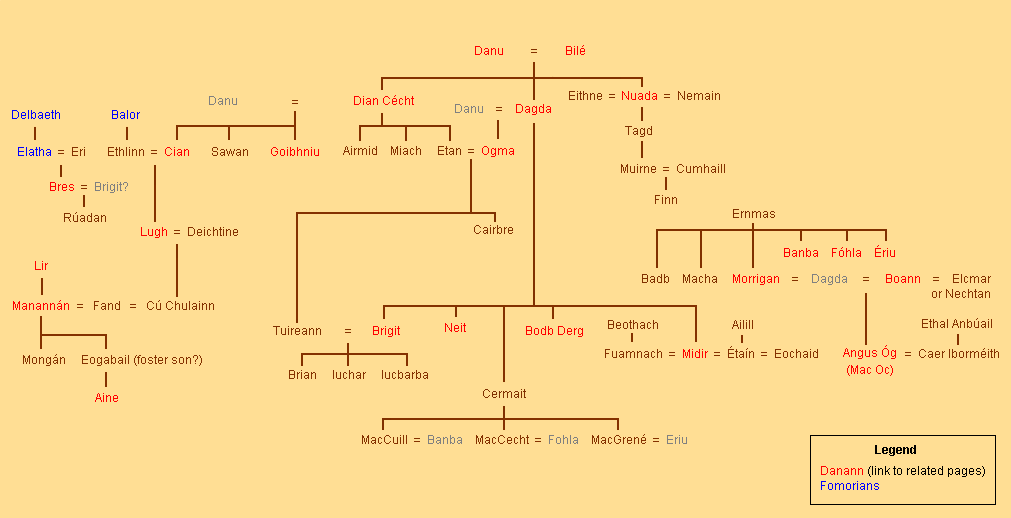Children of Danu
The Children of Danu were the people of Danu, or as the Irish called them – the Tuatha Dé Danann. I have completed several different versions of the genealogy of the Tuatha Dé Danann.
The Tuatha Dé Danann, like the other invaders of Ireland called the Firbolgs, were actually descendants of Nemed. Nemed had migrated to Ireland with his family and followers, known as the Nemedians, long before the arrival of the Firbolgs and the Tuatha Dé Danann. For this reason, I have included both the Nemedians and the Firbolgs on this page.
As for the last wave of invaders, the Milesians or descendants of Míl, you will find a separate page for the genealogy of the Milesians.
My main sources for these family trees comes from:
Lebor Gabálá Erenn: The Taking of Ireland
Cath Maige Tuired: The Second Battle of Mag Tuired
There are sources that can be used, which I have not read, such as
Dindshenchas
Duanaire Finn (Poem Book of Finn) 17th century
Nemedians
The Nemedians were children and followers of Nemed. Nemed was a direct descendant of the Biblical Noah, through Japheth and Magog, Noah's son and grandson. According to the Book of Invasions, Magog settled around the Russian Steppes, the kingdom of the Scythians. Later, Nemed would leave Scythia before migrating to Ireland. See the Nemedians in the Book of Invasions.
After the ruinous war against the Fomorians, the surviving Nemedians left Ireland. Several groups of people were descendants of the Nemedians, including the Firbolgs and the Tuatha Dé Danann.
Fergus Lethderg, Nemed's son, migrated to Alba (Scotland) with his son, Britain Máel, of whom the whole island was named after.
Semion, the great-great-grandson of Nemed, would migrate to Greece, where they later became known as the Firbolgs. The Firbolgs returned to Ireland eleven generation after Semion.
Iobath, son of Beothach and the great-grandson of Nemed, also migrated east to the northern island of Greece, or else to the north-east of an unknown location. Iobath was the ancestor of the Tuatha Dé Danann, who later returned to Ireland shortly after the Firbolg migration.
See the Children of Danu in the Book of Invasions for more details about the Firbolgs and the Tuatha Dé Danann.
For the sake of convenience, I have included the Cesairians and the Partholonians in the Nemedian genealogy, so that you can see the close relationship that the Nemedians had with these other peoples.
Firbolgs
The Firbolgs or Fir Bolgs were the descendants of the surviving Nemedians who fled from Ireland to Greece. The Firbolgs arrived in Ireland 230 years after Starn departed from Ireland.
Seimon, the son of Erglan and great grandson of Starn (son of Nemed), was the leader who brought them to Greece. The Firbolgs didn't migrate to Ireland until eleven generations after Seimon.
Five sons of Dela migrated to Ireland with their family and followers, and they divided the whole isle between themselves. However, their power in Ireland was short-lived, because they only ruled for 37 years before the Tuatha Dé Danann arrived and defeated them.
The Firbolgs' last king was Eochaid Mac Eirc, whose wife Tailtiu was the foster mother of Lugh Lamfata, the Danann hero and solar god.
See also the Firbolgs in the Book of Invasions.
Below is the family tree of the Firbolgs, during the arrival of Tuatha Dé Danann and the First Battle of Magh Tuiredh.
Eochaid Mac Erc was the last Firbolg king in Ireland, and he died in battle. Eochaid was married to Tailtiu, daughter of the King of Spain, who was sometimes known as Magmor (though this could be the name of a place). Tailtiu was also the foster-mother of the Danann hero, Lugh Lamfada. One of the great fairs in Ireland was named after her. Lugh held a feast and funeral games after her death.
Tailtiu was the scene of a battle between the Danann and the Milesians, where the Milesians became the conqueror and the Danann were forced to live in the Otherworld.
Tuatha De Danann
The genealogies in Irish myths, particularly those of the Irish deities, are very confusing. Particularly if you decide to read from several different sources, to construct their family tree.
Not only those genealogies of the Tuatha Dé Danann could be conflicting or contradicting from one source to another, but the genealogy could be conflicting within the same material (source). This can be frustrating.
Here, I have set up several different trees for the sake of completeness. Unfortunately, the three genealogies are far from complete, since there is other material (sources or translated texts) that I have not yet read.
Please try to refrain from thinking that these genealogies are accurate, since Irish myths never claimed to be accurate. It was much easier completing a relatively accurate genealogy for the Welsh deities than for those of the Irish.
I have also a new tree called the Nemedians, whom the Tuatha Dé Danann and the Firbolgs descend from.
1st Genealogy
The first genealogy shows that most of the Tuatha Dé Danann come from the mother goddess, Danu. Danu or Anu in the Irish legends may have played a more important role in early Irish myth.
2nd Genealogy
The alternative genealogy shows that some of the Tuatha Dé Danann are more closely related to the Fomorians.
For example, the Dagda and Ogma were seen as the son of Elatha, king of the Fomorians, and of Ethlinn, the daughter of Balor of the Evil Eye (a Fomorian leader).
Note that all of the Tuatha Dé Danann and the Fomorians shown below are descendants of Alldui, a shadowy figure. Alldui was the grandfather of Neit and the great, great grandson of Nuada Airgetlám (Nuada of the Silver Hand). To avoid more confusion, I decided to leave out Alldui's different ancestors.
3rd Genealogy
Below, is another alternative genealogy, which shows that the seven Danann champions or chieftains happened to be the seven sons of Ethliu.










